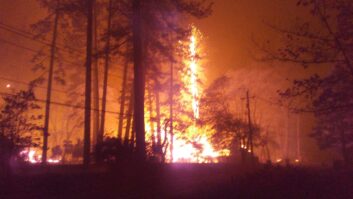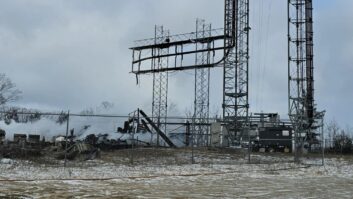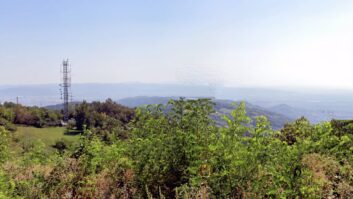An antenna manufacturer is explaining the series of events that led to a tower fire on the master FM antenna at West Tiger Mountain near Seattle earlier this month.
Tom Silliman, president of Electronics Research Inc., says storm damage or vibration caused a brass bolt, which was welded to one of the monopole radiating elements in the upper half of the array, to break in half inside a fiberglass insulator.
“This radiating element did not fall to the ground when the bolt broke because the radiating element was inside the plastic radome, and the plastic radome was attached to the reflector screen holding the element and plastic radome in place. The one port of the balun started arcing across the broken bolt causing the metal of the bolt to melt on both sides of the gap where the bolt broke. The feed point of the monopole has a low impedance thus causing the arc to begin,” Silliman wrote in an email to Radio World.
[Read: Tower Fire Disrupts Seattle Radio]
“As the arcing continued, the arcing began to make the hole in the fiberglass insulator bigger and bigger with time until the hole allowed the arc to catch the plastic radome on fire. As this plastic radome began to burn, melted plastic began dripping down on other plastic radomes causing the fire to spread,” he said.
Silliman says the master antenna had been in service at the Tiger Mountain American Tower facility for 19 years.
Silliman continued, “Finally, the plastic radome holding the monopole in place was melted away enough to allow the monopole with the broken bolt to fall to the ground. Both the element on the ground and what was left of the feed inside the element insulator had melted metal ends.”
The initial symptom of the failure would have been a loss of pressure, Silliman added.
The fire on November 8, which was clearly visible on the mountain top from miles away, disrupted operations for six Seattle FM stations located on the master antenna, including Entercom’s KSWD(FM), iHeartMedia’s KBKS(FM), KJAQ(FM) and KZOK(FM), and Hubbard’s KNUC(FM) and KQMV(FM). The radio stations are still broadcasting from aux sites on nearby Cougar Mountain.
A crew from ERI visited the site within days to begin the process of determining what caused the fire, Silliman said.
“(The crew) measured the damaged antenna, surveyed the site, climbed the tower, opened various components on the tower, and put pressure caps on the two 6 1/8 50 ohm rigid coaxial feed lines feeding the antenna,” Silliman said. “The crew did observe heat damage inside some of the components of the upper half of the array.”
If the antenna is refurbished, a new radome design will be used utilizing flame-retarding plastic radomes, Silliman said. “And we will upgrade the antenna to our current improved panel antenna design. Modern system monitoring available today can monitor everything including system pressure and pressure system run times, but with a site like Tiger Mountain that is difficult to get to, one would likely not have had the time to get to the site, find the problem, and avoid the fire.”
Silliman said a future radome fire at the tower on Tiger Mountain shouldn’t be possible with a modified ERI panel with fire-retarding plastic radomes and elements upgraded to our current 1180 panel antenna design.
[Want more information like this? Subscribe to our newsletter and get it delivered right to your inbox.]












